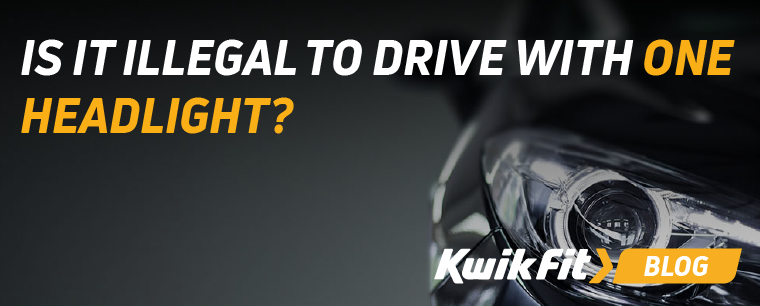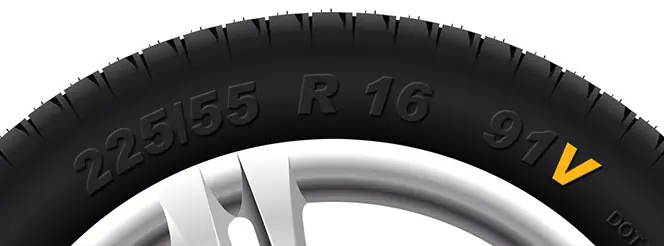What is Wet Braking & What Impacts it?
Kwik Fit | Monday 23rd December 2024 9:00am

It’s safe to say that the UK’s motorists are no strangers to a little bit of rain — from a light drizzle to torrential downpours that start seemingly out of nowhere. But, how prepared are we to safely bring our cars to a stop in wet weather? Whilst it’s generally accepted that braking in the rain takes longer, how much is understood about the role that our tyres play in wet braking?
In this blog, we’ll explore how differences in tyre tread affect our driving and what other factors impact us when we need to wet brake. We’ll also cover what we can do to make sure we are in the best position to brake in an emergency.
What is wet braking?
Wet braking refers to the process of a vehicle’s brakes and tyres stopping it on a wet or slippery road surface, where reduced traction can significantly impact braking performance.
When braking on dry road surfaces, a car’s tyres have much more grip and encounter much more friction with the road, so the brakes don’t have to work so hard to stop the engine. However, in wet weather conditions, the layer of liquid between the road and the tyre reduces traction and makes it harder for your braking system to stop.
In severe cases, hydroplaning or aquaplaning creates a barrier between the road and the tyres, which makes it very difficult or, in rare cases, impossible to steer, brake, or accelerate.
Factors that impact wet braking
As with most driving conditions, there are always variables that affect your driving. When it comes to wet braking, there are a number of factors that play a part in how quickly a vehicle is able to safely stop. Below, we’ll look at each in turn.
Tyre Conditions
Your tyres play a huge role in how you brake — from the tread depth to the pressure of the tyre. In the video above, you can see just how much of a role tread depth plays when you brake on a wet surface. The shallower the tread depth, the harder and slower it is to brake completely, causing longer stopping distances and excessive skidding.
Having good tread on your tyres (referring to the distance between the highest point of your tyre to the lowest part of the grooves or ‘snipes’), will help your car disperse water as you drive.
If your tread depth is shallow or barely legal (1.6mm), you run the risk of aquaplaning which could result in collisions or crashes. Having the right tyres to suit your car and investing in new, premium tyres will help you brake quicker. Also, checking your tyre's tread depth is a really important part of good car maintenance. Your tyres will also need to be the right pressure for your car and not over or underinflated:
- If your tyres are overinflated, you’ll have less contact with the road making it harder to brake safely.
- Conversely, having your tyres underinflated will mean that you have more contact with the road, causing excessive drag beyond what is necessary and wearing your tyres down sooner.
Having properly inflated tyres will give you optimal contact with the road, and will allow you to brake in the quickest time. You can get your tyres checked for free with us to give you peace of mind!

The surface of the road
The material of the road, its drainage quality, and any debris or oil on the road will also impact wet braking. Whilst smooth concrete can become slippery fast, asphalt has better water-draining properties. Concrete roads, on the other hand, are more likely to pool water into puddles, which can be dangerous for aquaplaning.
As for debris and oil, when rainwater is mixed with oil and dirt, it creates a slick layer on the road, especially after the first rainfall after a dry spell. This thick layer will reduce traction significantly, making braking less effective.
The speed of the vehicle
The faster the speed of your vehicle, the harder it is to brake, as there is so much momentum built up.
When there are wet conditions, braking distance grows exponentially, which is why there needs to be a generous gap between cars to allow for that braking time should a driver need to emergency stop.
When you’re travelling at high speeds in wet conditions, your tyres may lose contact with the road entirely, resulting in you gliding on water or ‘hydroplaning’. If this happens, it is nearly impossible to brake until your tyres make contact with the road again, making you susceptible to losing control of your vehicle and crashing.
Braking system health
The health of your braking system will impact your wet braking abilities massively. For example, worn or damaged brake pads or discs can reduce braking efficiency as brake pads with excessive wear may take longer to create the needed friction to stop your car.
If you have a malfunctioning ABS (Anti-lock braking system), you can increase the chance of skidding whilst you’re trying to brake because the tyres may lock. This, combined with wet conditions, will make it harder to brake effectively.
You will also need to make sure that your brake fluid is not contaminated or old as this will reduce the braking system’s efficiency, especially in emergencies.
How can you improve your wet braking performance?
Being prepared for wet weather driving scenarios is critically important for the health of your car and for the safety of everyone on the road.
- Checking your tyres regularly and investing in high-quality, all-weather tyres will put you in a better position.
- Having your brakes serviced or replaced — including pads, discs, and your ABS for every 30,000 miles or when you notice something off with them — is a good practice to keep on top of your car’s brake health.
- Finally, reducing your speed to shorten your stopping distance during wetter weather conditions is a best safety practice you should be following.
How Kwik Fit can help
At Kwik fit, we can offer you free tyre checks to make sure your tyres are compliant with UK laws. You can find your local centre or contact us with any concerns and questions you have regarding your vehicle — from checking your car brakes to booking an MOT.
Check out our blog for more driving inspiration and our guides for best car practices, including more tips for driving in wet weather. We’re ready to help you — no matter the weather.
Any facts, figures and prices shown in our blog articles are correct at time of publication.
Featured Articles
Is it Illegal to Drive With One Headlight?
Saturday 19th July 2025
Wondering if it’s illegal to drive with one headlight? Learn about the safety risks and penalties of illegal blown bulbs and why you should fix them promptly.
Air Con in EVs & Hybrids: Experts Answer Your Questions
Monday 30th June 2025
Does air con drain EV batteries? Can you use the air con while charging an electric car? Find out the answers to these questions & more from Kwik Fit’s experts.
Why Is Your Car Making a Noise? Fixes & Tips
Friday 13th June 2025
When your car starts making unexpected noises, it can certainly be quite disconcerting; it may be nothing to worry about, but here’s what you need to know.









